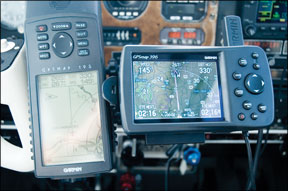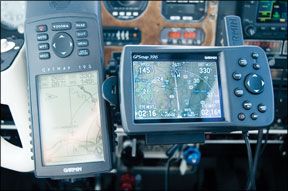Whenever we fly from point A to point B, many of us use the Victor airway system. We pick a route that offers us the smallest increase beyond a great circle distance, or the highest groundspeed and these days, especially perhaps the widest berth from unfriendly airspace. Not always will we get the route we filed and, too often, 288 the cleared route will put us at a major disadvantage. Of course, we cant choose a route at random; in the real world of IFR, theres more to it. Yes, an Instrument-rated pilot has the benefit of being “in the system,” by filing and, as such, is accorded the same privileges given to an airline captain. And, yes, ATC is there for your convenience and protection, not the other way around. But why is it that the routes were assigned often are so circuitous, and why is it when we have the necessary avionics to follow through and ask for a shortcut, the response is “unable”? The answer is simple, conceptually. Its so simple that you probably already suspected it. Its the circumstances that can stand a little explaining. Its A Jungle Out There The answer of course is that the relatively high speeds of aircraft combined with the inherent uncertainties of networked radar sites, as well as the existing structure of the National Airspace System (NAS) and ATC procedures along with a healthy respect for built-in safety margins dictate certain separation minima. Of course, the very system of VOR facilities and Victor airways covering the country implies the system is intolerant of “roll your own” individualism. In addition, theres the fact that one person can manage only a small chunk (or “sector”) of airspace and, until only recently, the historical precedent was that the most time-consuming job for a controller was calling another controller downstream to coordinate a hand-off. When an altitude or route change is involved, even more coordination becomes necessary. To see one of the ways the “system” evolved to help save time, you only have to look in the back of the Airport/Facility Directory (A/FD) at the section for Preferred IFR Routes and if youre in the northeast corridor or southern California beehives, the section for Tower Enroute Control to see what I mean. Someone figured out a long time ago that its easier to herd cattle when theyre not roaming all over the Ponderosa and the same thing is true with aircraft “we have to put them together to keep them apart.” Naturally and in addition to local traffic constraints, events further along your route may conspire against you. There might be a live MOA, deviations around weather, impromptu changes from a local Traffic Management Unit, or even from the Central Flow Control Facility in Washington. And that isnt even considering “bandwidth” and other communication system or computational capacity issues. All it takes is one trip to the radar room, seeing the skies from the other side of the microphone, to appreciate what goes on behind the scenes. Hidden agendas: As Instrument-rated pilots know, you can file whatever route you like, but often the Centers “Host” computer has other plans. And when its busy, unless youre on fire, “getting direct” is unlikely. This holds true on an en route scale as well as a local one. In addition to having a pre-established route structure, there are also procedures between individual ATC facilities that trim down lengthy coordination efforts. These might include Center-to-Center, Tracon-to-Center, as well as those between adjacent approach control facilities. You cant look them up in the green books, but the controllers sure use them; theyre known as letters of agreement, or LOAs. The sidebar above gives a brief overview of LOAs. Suffice it to say that LOAs are a fact of life, a cost of doing business and a variety of other clichs, all rolled into one. Picking the Philadelphia, Penn. (PHL), area as one example, there are LOAs with the New York Tracon and ARTCC as well as with the facilities at Baltimore-Washington International, Atlantic City, N.J., Reading, Penn., Allentown, Penn., Dover, Del., and, well, you get the picture. The result is that even on a local scale and PHL is just one example there are only certain ways you can get in or out. The simple summation is that there are different “corridors” for different directions. So this is the Way of Things. Until Free Flight and other advanced initiatives become the norm in the NAS and perhaps not even then the bottom line is that what we pilots consider a simple request is actually…well, sometimes, it aint so simple. Controllers know darn well that we value our time and our money, whether were flying a Bonanza or a business jet. Perhaps theres someone slower up ahead, and your request for “direct” would compromise their “miles in trail” restriction. Possibly youre on a busy airline jet route and the good of the many must outweigh the wishes of one Citation captain whatever. Speaking for myself, I realize I wont usually have the big picture, so I often shrug my shoulders and roll with it. Not always the bums rush: All that said, it still never hurts to inquire. Theres an implicit give and take involved; its not all “take.” You cant expect good service unless you ask ATC for what you want. And controllers cant read minds, so you do have to ask. There is a bright side to all this for us small fry. Here are several thoughts you might want to keep in mind: Ask:
Probe:
Any given ATC clearance is just one possible means of getting you on your way. Unless its just what you wanted, consider asking for better. (You dont buy a car at the sticker price, do you?)Inform:
Giving the controller the reason for your request can be effective, because people are often more obliging when they can understand or relate to whats going on.Deal:
If you cant do what they want you to, offer another solution. Theyll warmly appreciate someone willing to meet them halfway. Usually. And “unable” doesnt mean “impossible;” if youre apprehensive about shock cooling or airsick passengers, use the “U” word. (Note: If ATC says “expedite” or “immediately,” forget this!)Persevere:
If one controller denies your request, dont roll over and play dead. If he or she appears to have the time, engage them by offering a Plan B. Even if youre not successful, the next sector controller might be able to work out what you want.Lead:
Never hesitate to do what you feel you must. Never renounce your command authority, and dont be intimidated. Again, the system is there for your convenience and protection, not the other way around. If safety is absolutely the issue, you can always sort it out later, when youre safely on the ground.Confront:
If you unconditionally conclude the controller is being unfair or irrational, its time to make your day as PIC. Asking for operating initials and the telephone number of the watch supervisor cuts to the chase in a hurry, if its warranted.Learn:
If youre really a regular traveler to or through a specific Tracon, go and visit them. Call ahead, of course, or sign up for one of the highly successful “Operation Raincheck” programs. If you ask, youll learn about arrival corridors, metering, fix crossing altitudes and all manner of very useful details on local “adaptation data” that will probably save you time, and make their lives easier as well.Its All Negotiable
Sure, wed all like the red carpet treatment, and no one takes much of a shine to being treated like a hick from the sticks. And there may be times when direct might not work for you, even if its offered. Dont think so? If it meant bucking a headwind at a higher altitude, or an offshore Victor airway like V44, the “shark route” between the South Jersey coast and Long Island, then youd probably have to turn it down.
And yeah, we cant all be Frank Sinatra up there; ATC isnt Burger King, and you cant always have it your way. Its a bit like life, though. As Sam Levenson once said, if you want a helping hand, youll find one at the end of your arm.




